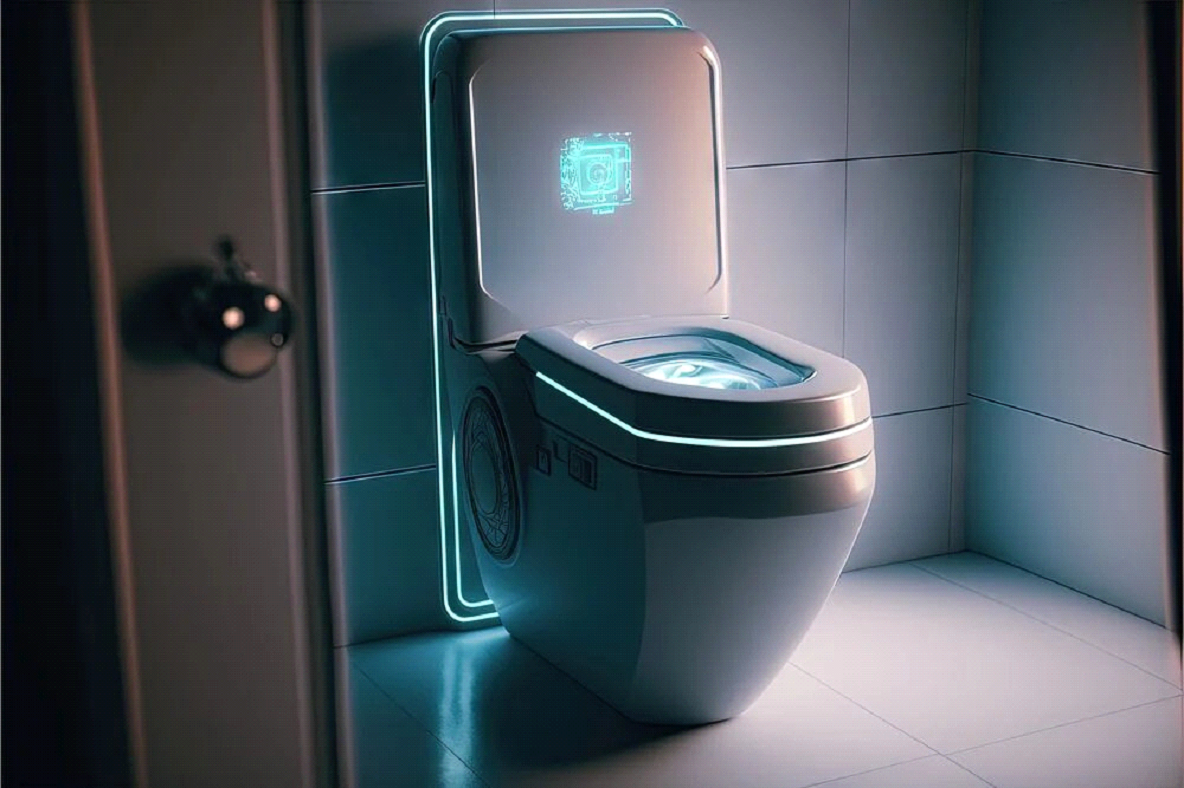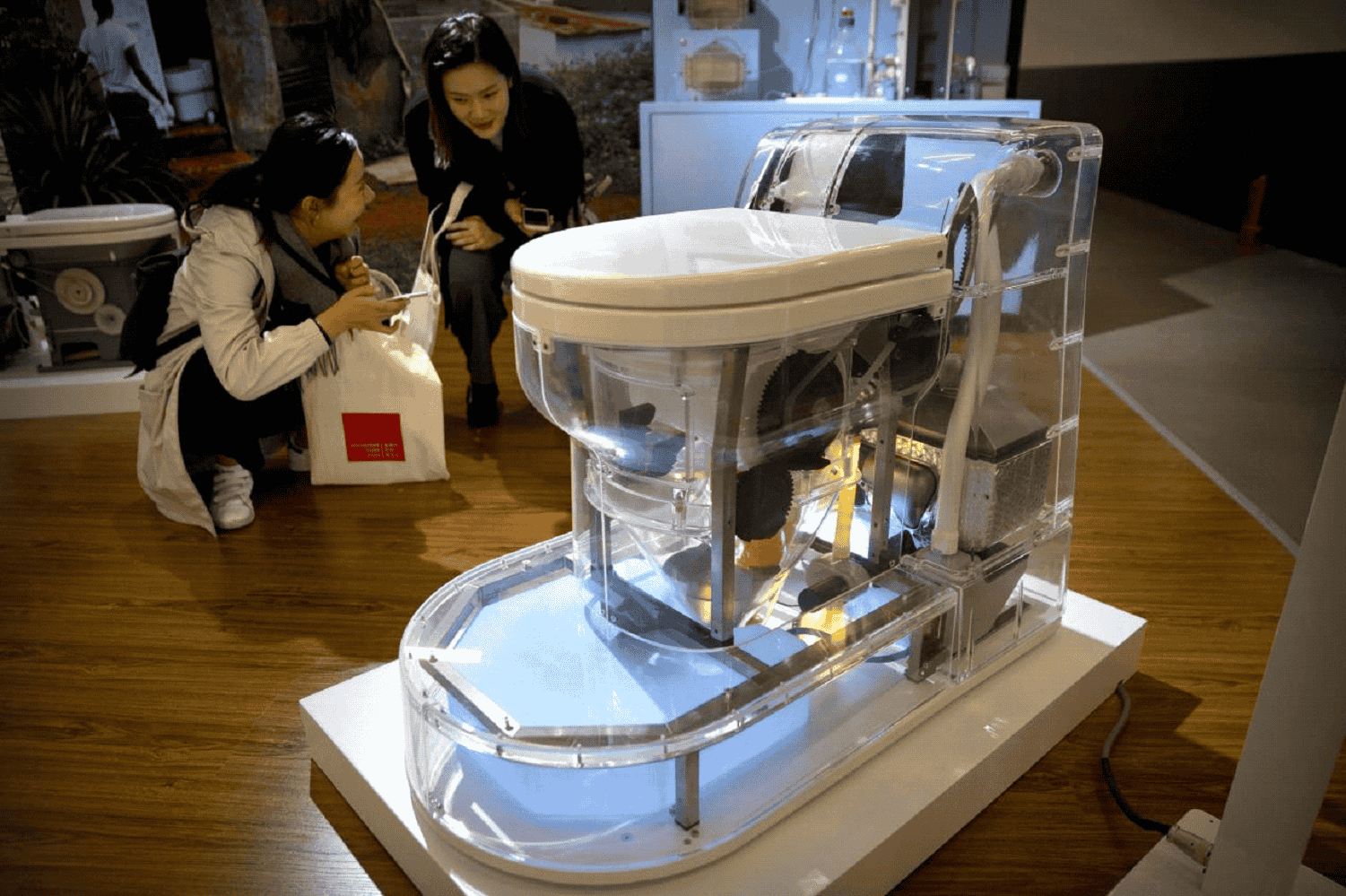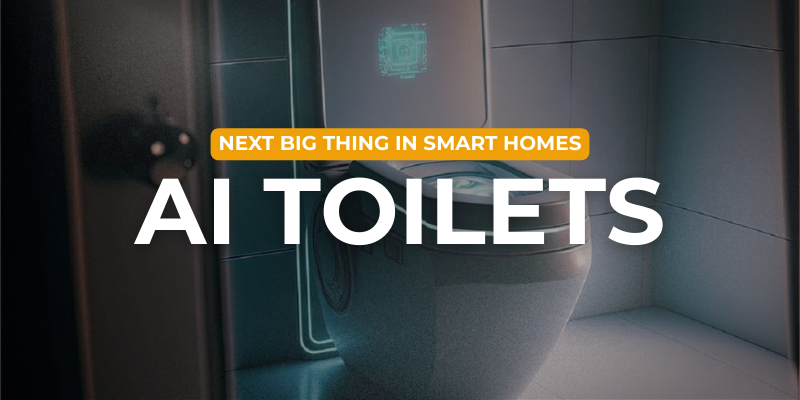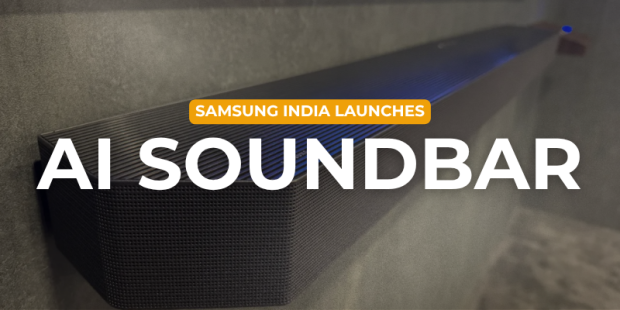Over the past few years, the smart home industry has exploded in popularity. From voice-activated speakers and intelligent lighting to smart locks, more and more household products are moving beyond single-function designs toward connected, intuitive, and proactive experiences. In fact, data shows that by 2024, the global smart home market surpassed $1.2 trillion, with a compound annual growth rate of over 15%. Even in China, one of the core markets, smart home adoption jumped from 12% in 2019 to 28% in 2024.
Amid this wave of innovation, bathroom technology has quietly emerged as a surprising hotspot. AI-powered smart toilets, in particular, are taking the humble bathroom fixture to a whole new level, transitioning from niche luxury items to mainstream essentials.
Unlike standard smart toilets that offer basic automation—like self-flushing or heated seats—AI toilets combine artificial intelligence, IoT connectivity, and advanced sensors to deliver a truly proactive experience. They can learn household members’ routines, monitor health data, and seamlessly integrate with broader smart home ecosystems. The result? Personalized convenience, enhanced wellness, and a level of sophistication that traditional toilets simply can’t match.

In this article, we’ll dive into why AI toilets are set to become the next big trend in smart homes and explore how they’re reshaping modern household lifestyles.
Part 1: The Evolution of Smart Toilets — From Simple Upgrades to an Intelligent Revolution
The history of toilets is more than just plumbing—it reflects the ongoing interplay between human needs and technological innovation. Today, AI is the driving force pushing smart toilets from functional upgrades to truly intelligent devices.
Traditional Toilets: Basic Bathroom Necessities
Before the 1990s, most households relied on standard ceramic toilets, serving only the basic purpose of sanitation. Flushing and cleaning were manual, often inconvenient, and unhygienic. Ideas like “comfort” or “intelligence” simply weren’t part of the equation.
Automatic Flush Toilets: The First Steps Toward Smart Features
In the 1990s, Japanese manufacturers introduced toilets with automated flushing and other early conveniences. Features like button-operated self-cleaning, warm air drying, and basic automation addressed hygiene issues, but these systems were still reactive—mechanical tools rather than intelligent assistants.
Smart Toilets: Digital and Automated Integration
By the 2010s, the combination of sensors and IoT technology fueled a new generation of smart toilets. Infrared detection, remote control, adjustable water temperature, heated seats, deodorizing, night lights, and automatic lids became increasingly common. These toilets could respond to user actions and offer customization, yet they still lacked true predictive intelligence or autonomous decision-making.
AI-Powered Smart Toilets: From Automation to Intelligence
Since 2020, AI integration has transformed toilets into advanced, data-driven devices. Modern AI toilets use multi-dimensional sensors and machine learning to understand user habits, analyze usage patterns, and provide predictive services. Some even include facial recognition to recall personalized settings or waste analysis to detect potential health issues—turning the bathroom into a hub for both comfort and wellness.
Market Adoption Is Accelerating
The adoption of AI toilets is rising rapidly. In China, AI-enabled toilets represented 22% of sales in 2024, up from just 5% in 2021, with a remarkable 68% year-over-year revenue growth. In Japan and South Korea, household penetration exceeds 35%. Consumers increasingly value personalization, health monitoring, and seamless integration with smart home ecosystems, shifting the industry from function-focused competition to experience-driven innovation.
Part 2: How AI Makes Smart Toilets Smarter — Four Key Upgrades
Traditional smart toilets are essentially automated devices with buttons. AI-powered toilets, on the other hand, act like intelligent personal assistants for your bathroom. By combining advanced sensors, algorithms, and connectivity, they elevate the user experience across four key areas:
1. Sensors and Automation: From Manual to Proactive
Modern AI toilets use multi-dimensional sensors to detect presence, weight, and distance. They handle tasks automatically—lid opening, seat heating, flushing, and deodorizing—eliminating the need for manual steps. Environmental factors like temperature, humidity, and airflow are dynamically adjusted for comfort. Some models even send alerts for missed flushes or misaligned seats, helping reduce user errors and maintain hygiene effortlessly.
2. Personalized Experience: From One-Size-Fits-All to Tailored
AI toilets create personalized profiles based on user data such as usage times, water temperature, nozzle position, and flush strength. Multi-user recognition—through facial scanning, fingerprints, or Bluetooth pairing—automatically applies individual preferences. Predictive algorithms can anticipate special needs, such as adjusting for pregnancy, illness, or personal routines, delivering a truly tailored experience for every household member.
3. Health Monitoring: From Bathroom Tool to Wellness Hub
AI toilets are increasingly doubling as wellness devices:
⦁ Waste analysis: Sensors can assess color, shape, and composition to identify digestive issues, detect blood in stool, or flag potential urinary infections.
⦁ Urine testing: Advanced models can detect glucose and protein levels, helping monitor potential risks for diabetes or kidney problems.
⦁ Data tracking: Long-term trends sync with health apps, and abnormal readings can trigger alerts or prompt medical appointments.
Note: While AI toilets provide valuable health insights, they are not a substitute for professional medical diagnosis.
4. Energy Efficiency and Sustainability
AI toilets are designed with eco-conscious features:
⦁ Adaptive water usage: Flush volume adjusts based on user and waste type, saving over 30% water compared to conventional toilets.
⦁ Smart power management: Seat heating schedules adapt to peak usage times, reducing electricity costs.
⦁ Consumables monitoring: Sensors track filters and cleaning supplies, automatically sending alerts when replacements are needed.
Part 3: Role in Smart Home Ecosystems — The Bathroom as a Connected Hub
AI toilets are not just high-tech fixtures—they’re daily-use devices that transform your bathroom into a fully connected node within the smart home ecosystem.
Cross-Platform Connectivity
Modern AI toilets work seamlessly with major smart home platforms, including Alexa, Google Home, Xiaomi Mijia, and Huawei HarmonyOS. Voice commands can control seat temperature, deodorizing functions, and more. Unified app management allows you to create “bathroom scene” presets, integrating lighting, ventilation, and heating for a perfectly synchronized environment. Health data can even sync with wearables, giving you a comprehensive view of wellness while optimizing energy use.
Scenario-Based Automation
AI toilets adapt to your lifestyle with intelligent, scenario-based automation:
⦁ Morning wake-up mode: Preheats the seat, adjusts lighting, activates ventilation, and even plays your favorite audio to start the day comfortably.
⦁ Night mode: Low-intensity night lights, ambient temperature control, and noise suppression for a safe and relaxing experience.
⦁ Health monitoring scenarios: Abnormal readings can trigger alerts to family members, suggest medical appointments, and provide guidance for follow-up care.
Overall Experience Upgrade
AI toilets enhance the bathroom experience across four key dimensions:
⦁ Convenience: Streamlined operations reduce effort and simplify routines.
⦁ Comfort: Environmental adjustments create a consistently pleasant experience.
⦁ Health: Daily monitoring supports overall family wellness.
⦁ Safety: Features like anti-electric shock, anti-dry burn, anti-siphon, and remote alerts provide added security and peace of mind.
With AI integration, the bathroom is no longer just a functional space—it becomes an intelligent, connected hub that contributes to convenience, health, and comfort throughout the home.
Part 4: Lifestyle Impact — Tailored for Every Household Member
AI toilets don’t just clean—they enhance daily life for everyone in your home, adapting to each person’s needs and routines.
Family Comfort
AI toilets simplify everyday routines for busy adults and caregivers alike. Multi-user personalization resolves conflicts over seat temperature, water pressure, and nozzle settings. Automatic deodorizing and self-cleaning features help maintain a consistently hygienic environment without extra effort.
Special Needs
- Elderly users: Motion sensors and health monitoring provide both convenience and safety, reducing risks of slips or missed alerts.
- Children: Adjustable lower seat heights, gentle water pressure, warm air drying, and night-light modes ensure safety and comfort for younger family members.
- Health-conscious individuals: Non-invasive daily monitoring tracks key metrics, helping users manage chronic conditions or stay proactive about wellness.

Personalized Modes
AI toilets offer tailored modes to match lifestyle preferences:
- Minimalist mode: Focuses on core functions with simplicity and efficiency.
- Luxury mode: Integrates aroma diffusers, smart mirrors, and music for a spa-like experience at home.
- Eco mode: Optimizes water and energy usage, providing real-time feedback to reduce environmental impact.
By catering to the unique needs of every user, AI toilets turn a simple bathroom visit into a personalized, convenient, and even enjoyable experience—making them an integral part of a modern smart home.
Part 5: Market Trends and Future Outlook
AI smart toilets are no longer a niche luxury—they’re quickly emerging as a major segment in the smart home market, with billion-dollar potential.
Global and Regional Market Potential
In 2024, the global market for AI-enabled toilets reached approximately $18 billion, and it’s projected to climb to $50 billion by 2029, reflecting a robust CAGR of 22.3%. The Asia-Pacific region is leading this growth, with China, India, and Southeast Asia accounting for roughly 60% of demand. Within China, government initiatives, tech-savvy younger consumers, and rapid urbanization are driving adoption, with lower-tier cities showing particularly strong sales momentum.
Integration with Smart Home Ecosystems
AI toilets are increasingly designed to work as part of a fully connected smart home:
- Cross-device data: Health metrics from the toilet sync with wearables, smart scales, and sleep trackers for comprehensive wellness tracking.
- Coordinated services: Features like automatic water heater adjustment, massage seat activation, and real-time notifications enhance daily convenience.
- Whole-home optimization: Usage patterns inform energy allocation, water scheduling, and other household routines, making the bathroom an active contributor to overall home efficiency.
Future Technology Directions
The next wave of AI toilets will focus on smarter, more precise, and fully integrated capabilities:
- Advanced AI algorithms: Waste and urine analysis will become more accurate, with predictive accuracy rising from 75% to over 90%, helping users track health trends more effectively.
- Enhanced IoT and predictive intelligence: Toilets will anticipate user needs, communicate with other smart devices, and contribute to a seamlessly intelligent bathroom ecosystem.
As AI toilets evolve, they’re set not just to redefine the bathroom experience but to become a central, connected element in the smart home—combining convenience, wellness, and data-driven personalization like never before.
Conclusion: AI Toilets—The Future of Smart Living
AI toilets are transforming the way we think about bathrooms. No longer just functional fixtures, they have become personalized wellness hubs, seamlessly integrating comfort, health monitoring, and smart home connectivity. From automated cleaning and climate control to predictive health insights, AI toilets offer a level of convenience and intelligence that was unimaginable just a decade ago.
As the smart home market continues to grow, these high-tech toilets are moving from early adopters to mainstream households. They don’t just enhance daily routines—they improve quality of life, support family wellness, and contribute to sustainable living through energy- and water-saving technologies.
For homeowners looking to embrace the future, AI toilets represent more than a gadget—they’re a lifestyle upgrade, a wellness tool, and a glimpse into the intelligent homes of tomorrow.










[…] comes equipped with a stunning Liquid Retina XDR display and a next-gen Neural Engine for great AI processing. With up to 22 hours of battery life, enhanced graphics performance, light-weight and […]
[…] unveils MAI-Image-1: In a new step toward advancing its generative AI capabilities, Microsoft has introduced MAI-Image-1 its first newly developed text-to-image model. […]
[…] in China: China is quickly changing its artificial intelligence powers, integrating AI into both military and […]